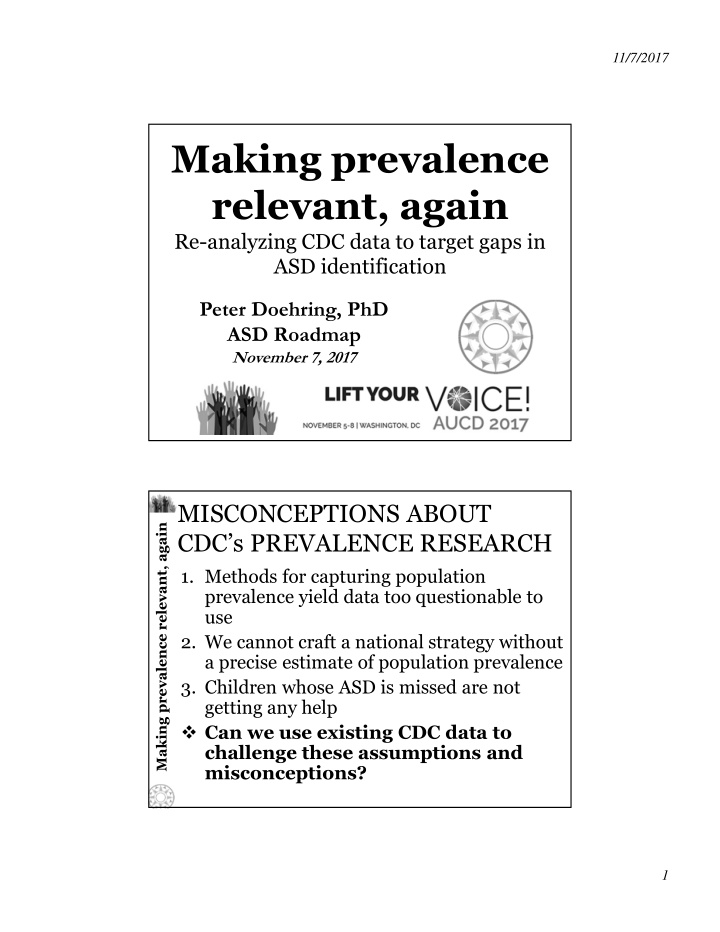



PPPP 11/7/2017 Making prevalence eter eter oehring oehring eter eter oehring oehring D D D D relevant, again oadmaps ASD R Re-analyzing CDC data to target gaps in ASD identification Peter Doehring, PhD ASD Roadmap November 7, 2017 MISCONCEPTIONS ABOUT Making prevalence relevant, again CDC’s PREVALENCE RESEARCH 1. Methods for capturing population prevalence yield data too questionable to use 2. We cannot craft a national strategy without a precise estimate of population prevalence 3. Children whose ASD is missed are not getting any help � Can we use existing CDC data to challenge these assumptions and misconceptions? 1
11/7/2017 1. ADMINISTRATIVE NOT Making prevalence relevant, again POPULATION PREVALENCE � Administrative prevalence: The number already labeled with ASD in our systems of care � CDC samples 8 year-old children referred to specialists and centers � So what is the CDC’s measuring? ─ Not population prevalence ─ Optimal administrative prevalence, or the number of children with ASD amongst those already referred to systems of care ADMINISTRATIVE PREVALENCE Making prevalence relevant, again CDC’s Methods � Provides a valid estimate for those ─ Already identified with ASD ─ Who would be diagnosed if properly assessed ─ Estimates based on file review are comparable to those based on full clinical assessment 2
11/7/2017 2. USE DISPARITIES IN Making prevalence relevant, again ADMINISTRATIVE PREVALENCE � A single, precise, and reliable, national estimate of administrative prevalence ─ May be unrealistic because of regional variations in services ─ Is unnecessary if we focus on disparities within & across states with available data � Disparities across states may capture state— state differences in practices & systems of care � Disparities within states may capture ─ Local differences in practices & systems of care ─ Disparities due to race, ethnicity, income DISPARITIES IN PREVALENCE Making prevalence relevant, again Closing Pennsylvania’s Gaps � In 2011, rates of identification per 10,000 varied from 11% to 39% of CDC’s projections of 1 in 68 ─ For every child identified in a Pennsylvania County in 2011, 2 to 8 more might be missed ─ Maybe 50% will be identified by 2023… or 2061 ─ Prevalence falls short despite Autism insurance, State Autism Agency, strong research centers � Who cares if prevalence is 1 in 58 or 68 or 78 when so many diagnoses are missed � CDC’s data reveal gaps that tell us a lot about ─ How many we are missing ─ Who are we missing? ─ How we are missing them? 3
11/7/2017 HOW MANY ARE WE MISSING Making prevalence relevant, again Estimating complete misses in SC � Complete miss: A child never diagnosed with ASD, maybe never seen by a specialist � Contrast prevalence in highest (NJ) and lowest (SC) states ─ For every child CDC identified with ASD in SC, another was completely missed HOW ARE WE MISSING THEM Making prevalence relevant, again Children who maybe got help in SC Targeted via school services: 22% ASD caught: Diagnosed by hospital but missed 42% by school: 13% Caught ASD signs: 8% ASD missed, other help sought: 13% Missed ASD signs: 5% All difficulties completely missed: 45% � Projections derived from merging NJ and SC prevalence data with 2011 validity study 4
PPPP 11/7/2017 WHO ARE WE MISSING Making prevalence relevant, again Ethnic Disparities for SC � For every 10 Hispanic children CDC identified with ASD in SC, ─ Another 10 to 20 might be completely missed ─ Only 1 or 2 might have a special education record that identifies ASD as their primary educational classification eter eter oehring oehring eter eter D D oehring oehring D D oadmaps ASD R For more information To contact me www.asdroadmap.org/making-prevalence- peter@asdroadmap.org relevant-again.htm 5
Recommend
More recommend